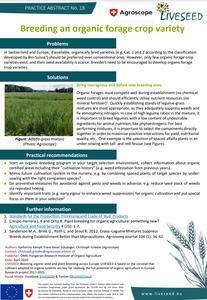{Tool} Breeding an organic forage crop variety (Liveseed Practice Abstract). Creator(s): Kempf, Katharina; Schubiger, Franz Xaver and Grieder, Christoph. Issuing Organisation(s): Agroscope. Liveseed Practice Abstract, no. 18. (2020)
|
PDF
- English
(Breeding an organic forage crop variety)
1MB | |
![[thumbnail of 2023-04-21 17_09_57-PowerPoint Presentation.png]](/37867/3.hassmallThumbnailVersion/2023-04-21%2017_09_57-PowerPoint%20Presentation.png)  Preview |
Image (PNG)
- Cover Image
- English
212kB |
Document available online at: https://www.liveseed.eu/wp-content/uploads/2020/04/PA18_How-to-breed-an-organic-forage-crop-variety.pdf
Summary
Practical Recommendations
- Start an organic breeding program in your target selection environment, collect information about organic certified areas including their “cultivation history” (e.g. weed infestation from previous years)
- Mimic future cultivation system in the nursery, e.g. by combining spaced plants of target species by under-sowing with the right companion species3
- Do preventive measures for avoidance against pests and weeds in advance, e.g. reduce seed stock of weeds via repeated hoeing
- Identify important traits (e.g. early vigour to enhance weed suppression) for organic cultivation and put special focus on them in your selection2
| EPrint Type: | Practice tool |
|---|---|
| What problem does the tool address?: | In Switzerland and Europe, if available, organically bred varieties (e.g. Cat. 1 and 2 according to the classification developed by Bio-Suisse1) should be preferred over conventional ones. However, only few organic forage crop varieties exist, and their seed availability is scarce. Breeders need to be encouraged to develop organic forage crop varieties. |
| What solution does the tool offer?: | Being courageous and define new breeding aims Organic forages must compete well during establishment (no chemical weed control) and should efficiently utilize nutrient resources (no mineral fertilizer)2. Quickly establishing stands of legume-grass mixtures are most appropriate, as they adequately suppress weeds and fix atmospheric nitrogen. In case of high legume ratios in the mixture, it is important to breed legumes with a low content of undesirable ingredients for animal nutrition, like phytoestrogens. For best performing mixtures, it is important to select the components directly together in order to maximize positive interactions for yield, nutritional quality, etc. One example is the selection of spaced alfalfa plants in an under-sowing with tall- and red-fescue (see Figure). |
| Country: | Switzerland |
| Type of Practice Tool: | Practice abstracts |
| Agrovoc keywords: | Language Value URI English seeds http://aims.fao.org/aos/agrovoc/c_6946 English plant breeding http://aims.fao.org/aos/agrovoc/c_5956 English varieties http://aims.fao.org/aos/agrovoc/c_8157 |
| Subjects: | Crop husbandry > Breeding, genetics and propagation |
| Research affiliation: | Switzerland > Agroscope European Union > Horizon 2020 > Liveseed European Union > Horizon 2020 > Liveseed > Liveseed tools |
| Horizon Europe or H2020 Grant Agreement Number: | 727230 |
| Related Links: | https://organic-farmknowledge.org/tool/37867, https://orgprints.org/37867, https://www.agroscope.admin.ch/agroscope/de/home.html |
| Project ID: | ofk |
| Deposited By: | Ortolani, Dr. Livia |
| ID Code: | 37867 |
| Deposited On: | 14 Apr 2020 07:16 |
| Last Modified: | 21 Apr 2023 15:10 |
| Document Language: | English |
| Status: | Published |
Repository Staff Only: item control page


